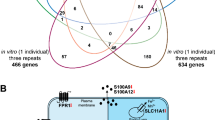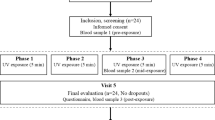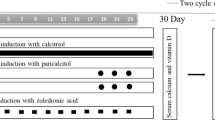Abstract
Synthesis of vitamin D in the skin in response to ultraviolet light is the main determinant of vitamin D status in man1 and it is therefore surprising that rickets and osteomalacia, clinical signs of vitamin D deficiency, remain common in tropical and subtropical countries2. Skin pigmentation can reduce vitamin D formation3 but this is a negligible limitation in people exposed to abundant ultraviolet light4,5. Earlier studies in animals6 and man7 suggested that another environmental factor, the low calcium/high cereal diet typical of susceptible populations2, might affect the efficiency of vitamin D utilization. We show here in rats that the rate of inactivation of vitamin D in the liver is increased by calcium deprivation. The effect is mediated by 1,25-dihydroxyvitamin D, produced in response to secondary hyperparathyroidism8,9, which promotes hepatic conversion of vitamin D to polar inactivation products that are excreted in bile. This finding has widespread implications both for understanding the pathogenesis of endemic rickets and in that it provides a unifying mechanism for the development of vitamin D deficiency in many clinical disorders.
This is a preview of subscription content, access via your institution
Access options
Subscribe to this journal
Receive 51 print issues and online access
$199.00 per year
only $3.90 per issue
Buy this article
- Purchase on SpringerLink
- Instant access to full article PDF
Prices may be subject to local taxes which are calculated during checkout
Similar content being viewed by others
References
Haddad, J. G. & Hahn, T. J. Nature 244, 515–517 (1973).
DHSS Report on Health and Social Subjects, 19 (HMSO, London, 1980).
Clemens, T. L., Adams, I. S., Henderson, S. L. & Holick, M. F. Lancet i, 74–76 (1982).
Stamp, T. C. B. Proc Nutr. Soc. 34, 119–130 (1975).
Davie, M. & Lawson, D. E. M. Clin. Sci. 58, 235–242 (1980).
Ewer, T. K. Nature 166, 732–733 (1950).
Robertson, I, Ford, J. A., McIntosh, W. B. & Dunnigan, M. G. Br. J. Nutr. 45, 17–22 (1981).
Garabedian, M., Holick, M. F., DeLuca, H. F. & Boyle, I. T. Proc natn. Acad. Sci. U.S.A. 69, 1673–1676 (1972).
Fraser, D. R. & Kodicek, E. Nature new Biol. 241, 163–166 (1973).
Gray, R. W., Weber, H. P., Dominguez, J. H. & Lemann, J. J. clin. Endocr. Metab. 39, 1045–1056 (1974).
Ribovich, M. L. & DeLuca, H. F. Archs Biochem. Biophys. 188, 145–156 (1978).
Fox, J. & Ross, R. J. Endocr. 105, 169–173 (1985).
Paulson, S. K. & Kenny, A. D. Biopharmaceutics and Drug Disposition 6, 359–372 (1985).
Lawson, D. E. M., Wilson, P. W. & Kodicek, E. Nature 222, 171–172 (1969).
Bell, P. A. & Kodicek, E. Biochem. J. 116, 755–757 (1970).
Anderson, G. H. & Draper, H. H. J. Nutr. 102, 1123–1132 (1972).
Siu, G. M. & Draper, H. H. Calc Tiss. Int. 33, 667–672 (1981).
Charbonne, G. A. & Hulstaert, P. E. Endocrinology 95, 621–626 (1974).
Groszmann, R. G., Vorobioff, J. & Riley, E. Am. J. Phystol. 242, G156–G160 (1982).
Ketterer, S. G., Wiegand, B. D. & Rapaport, E. Am. J. Physiol. 199, 481–484 (1960).
Bell, P. A. & Kodicek, E. Biochem. J. 115, 663–669 (1969).
Hahn, T. J., Hendin, B. A., Scharp, C. R. & Haddad; J. G. New Engl. J. Med. 287, 900–904 (1972).
Omura, T. & Sato, R. J. biol. Chem. 239, 2370–2378 (1964).
Braidman, I. P. & Anderson, D. C. Clin. Endocr. 23, 445–460 (1985).
Baran, D. T. & Milne, M. L. J. clin. Invest. 77, 1622–1626 (1986).
Sikorska, M. & Whitfield, J. F. Biochem. biophys. Res. Commun. 129, 766–772 (1985).
Woodhouse, N. J. Y., Doyle, F. H. & Joplin, G. H. Lancet ii, 283–287 (1971).
Stanbury, S. W. J. R. Coll. Phys. Lond. 15, 205–217 (1981).
Driscoll, R. H., Meredith, S. C., Sitrin, M. & Rosenberg, I. H. Gastroenterology 83, 1252–1258 (1982).
Dibble, J. B., Sheridan, P. & Losowsky, M. S. Q. Jl Med. 209, 119–134 (1984).
Morgan, S. B., Hunt, G. & Patterson, C. R. Q. Jl Med. 39, 395–410 (1970).
Teitelbaum, S. L., Halverson, J. D., Bates, M., Wise, L. & Haddad, J. G. Ann. intern. Med. 86, 289–293 (1977).
Dibble, J. B., Sheridan, P., Hampshire, R., Hardy, G. J. & Losowsky, M. S. Clin. Endocr. 15, 373–383 (1981).
Bell, N. H., Epstein, S., Greend, A., Shary, J., Oexmann, M. J. & Shaw, S. J. clin. Invest. 76, 370–373 (1985).
DeLuca, H. F., Guroff, E., Steenbock, H., Reiser, F. & Mannatt, M. R. J. Nutr. 75, 175–180 (1961).
Author information
Authors and Affiliations
Rights and permissions
About this article
Cite this article
Clements, M., Johnson, L. & Fraser, D. A new mechanism for induced vitamin D deficiency in calcium deprivation . Nature 325, 62–65 (1987). https://doi.org/10.1038/325062a0
Received:
Accepted:
Issue date:
DOI: https://doi.org/10.1038/325062a0
This article is cited by
-
Predicting the acute-phase response fever risk in bisphosphonate-naive osteoporotic patients receiving their first dose of zoledronate
Osteoporosis International (2022)
-
Increased calcium intake is associated lower serum 25-hydroxyvitamin D levels in subjects with adequate vitamin D intake: a population-based observational study
BMC Nutrition (2020)
-
Vitamin D status among the elderly Chinese population: a cross-sectional analysis of the 2010–2013 China national nutrition and health survey (CNNHS)
Nutrition Journal (2017)
-
Letter to the Editor on “Vitamin D-binding protein, vitamin D status and serum bioavailable 25(OH)D of young Asian Indian males working in outdoor and indoor environments”
Journal of Bone and Mineral Metabolism (2017)
-
Vitamin D expenditure is not altered in pregnancy and lactation despite changes in vitamin D metabolite concentrations
Scientific Reports (2016)



